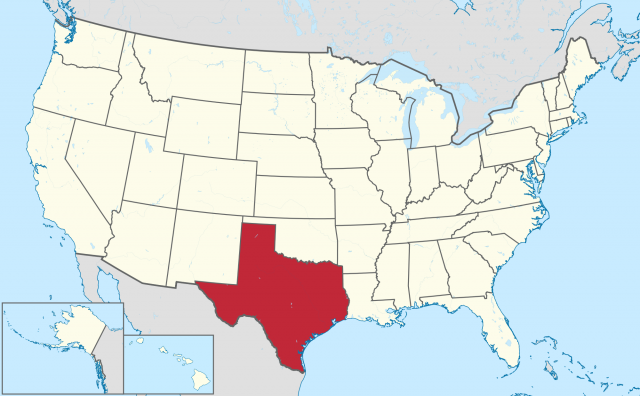Texas
TEXAS IS A SOUTHWESTERN state of the UNITED STATES, bordering LOUISIANA, OKLAHOMA, and NEW MEXICO. MEXICO lies across the RIO GRANDE to the south. Texas also has a 350-mi (560-km) coastline along the Gulf of Mexico. Texas now ranks second among the states in both area and population. With a total area of 268,581 square mi (695,622 square km), Texas is second in size to ALASKA. Texas remains, however, by far the largest of the 48 contiguous states. The state's highest point is Guadalupe Peak, which rises to 8,749 ft (2,667 m) in the Guadalupe Mountains of far-west Texas.
With an estimated 2003 population of 21,779,893, Texas has surpassed NEW YORK to become second in population only to CALIFORNIA. Texas's population is 12 percent African American and 33 percent Hispanic. The state's capital is Austin. Houston, with a 2000 census population of 1,953,631, is Texas's largest city, followed by Dallas (1,188,580) and San Antonio (1,144,646). Major industries include long-established petroleum and natural gas drilling and refining industries, as well as a large number of recently established high technology firms. Agricultural products remain vital to the economy; cotton, wheat, sorghum, pecans, and citrus are among the most important crops. The rearing of beef cattle—extremely important for the cowboy image that Texas continues to project to the world—is still an important industry.

Texas is big. In fact, its bigness largely defines the way Texans, and also the country and the world at large, think about Texas. It is roughly 800 mi (1,290 km) across Texas in both east-west and north-south directions. Because of the state's size, the landscapes of Texas are quite varied, ranging from sandy subtropical beaches along the southern gulf coast to mile-high mountains and arid deserts in the far west. Except for the mountains in the west, Texas has a tendency to be flat. A wide coastal plain extends inland from the gulf. Elevation gradually increases westward from the coast until the Balcones Escarpment is reached. This rather abrupt escarpment rises 300 to 500 ft (90 to 150 m) just west of a line connecting Waco, Austin, and San Antonio. To the west lies the rolling Edwards Plateau, the southernmost extension of the Great Plains. At its northern end the Edwards Plateau becomes the rather featureless Llano Estacado, which extends north into the Texas Panhandle. Elevations in the Edwards Plateau and the Llano Estacado range from 700 ft (210 m) in the south to over 1,200 ft (365 m) in the north.
Beyond the Edwards Plateau and west of the Pecos River, the mountainous part of Texas begins. This region includes a number of distinct mountain ranges, including the Guadalupe and Chisos mountains, as well as deep canyons cut by the Rio Grande. Texas's climate is as varied as its size. On the same winter's day it can be 90 degrees F (32 degrees C) at the mouth of the Rio Grande while a blizzard is raging in the Texas Panhandle. The natural vegetation cover of Texas includes pine forests in eastern Texas, mesquite-covered scrublands in southern Texas, extensive grasslands in northwestern Texas, and the yuccas and cacti of the Chihuahuan Desert within the “big bend” of the Rio Grande.
The oversized land of Texas has given rise to a population proud of its state, even to the point of bravado. Texas was the only state to become a state directly from a previous status as an internationally recognized independent state. Texas (its nickname “Lone Star State,” is a remembrance of its once independent status) joined the nation as a consequence of an agreement between equals. Texas had been lightly populated by native American tribes, although groups such as the Comanche left their mark on the lore of the state. Texas had been a part of the Spanish kingdom of New Spain and after the 1820s formed part of the newly proclaimed independent state of Mexico, although the Spanish-speaking population had always been small.
THE ALAMO
In 1821, the Mexican government authorized a colony (300 families) of English-speaking Americans to settle in Texas. This colony, established by Moses and Stephen Austin, eventually grew in size and was joined by other groups, mostly from the southern United States. These American settlers soon clashed with the central Mexican government over many issues, notably self-governance for the area and whether slavery— which many of the American settlers depended on— should be allowed. In 1836 these settlers, after a brief revolution highlighted by the famous siege of the Alamo, established the Republic of Texas. This republic survived as an independent state until 1845, when the United States finally allowed Texas to join the union—as a slave state.
The admission of Texas to the United States led to the Mexican War (1846–48), two major consequences of which were the American conquest of New Mexico and California and the extension of the boundaries of Texas west to El Paso. Texas avoided most of the military action of the Civil War, and slavery was abolished in 1865. Texas's population and economy grew rapidly throughout the 20th century, thanks largely to the exploitation of immense natural reserves of petroleum. Texas's political power within the United States mushroomed as well. Of the 11 U.S. presidents who served in the decades following World War II, four had Texas roots: Dwight Eisenhower and Lyndon Johnson were born in Texas, while George H.W. Bush and George W. Bush, although born elsewhere, built their careers in Texas politics.